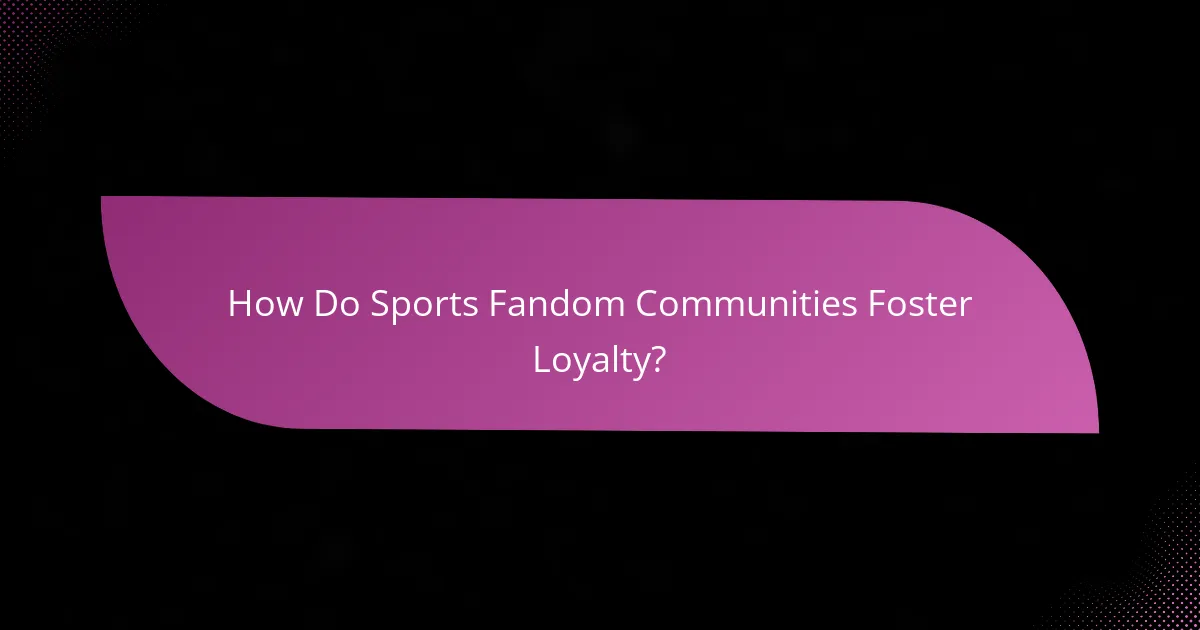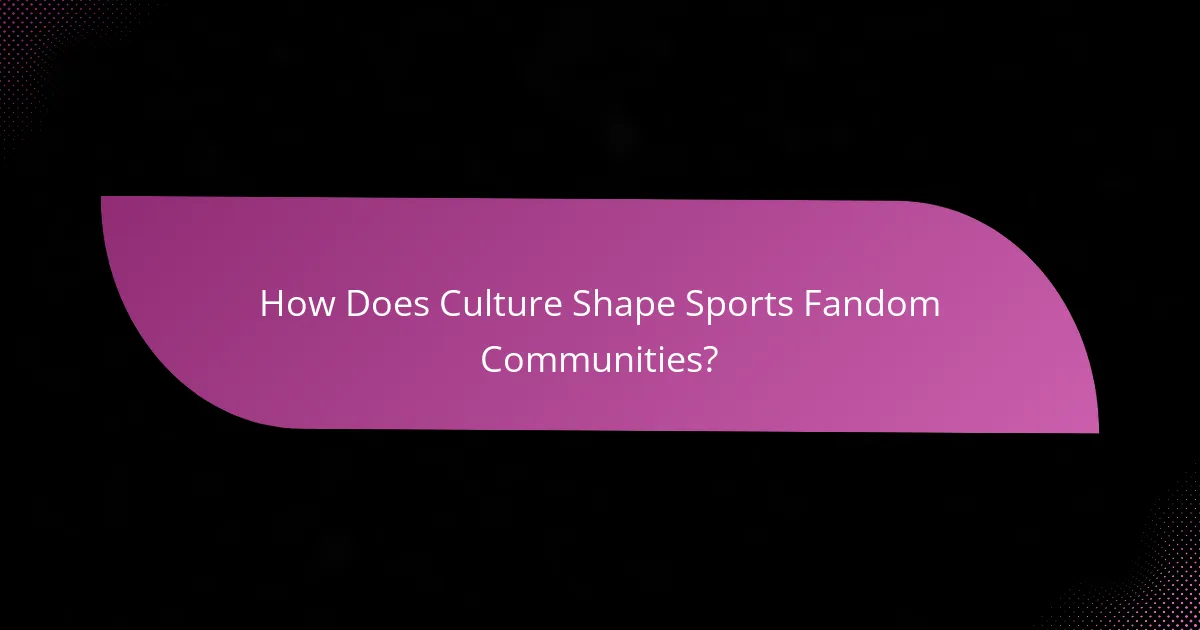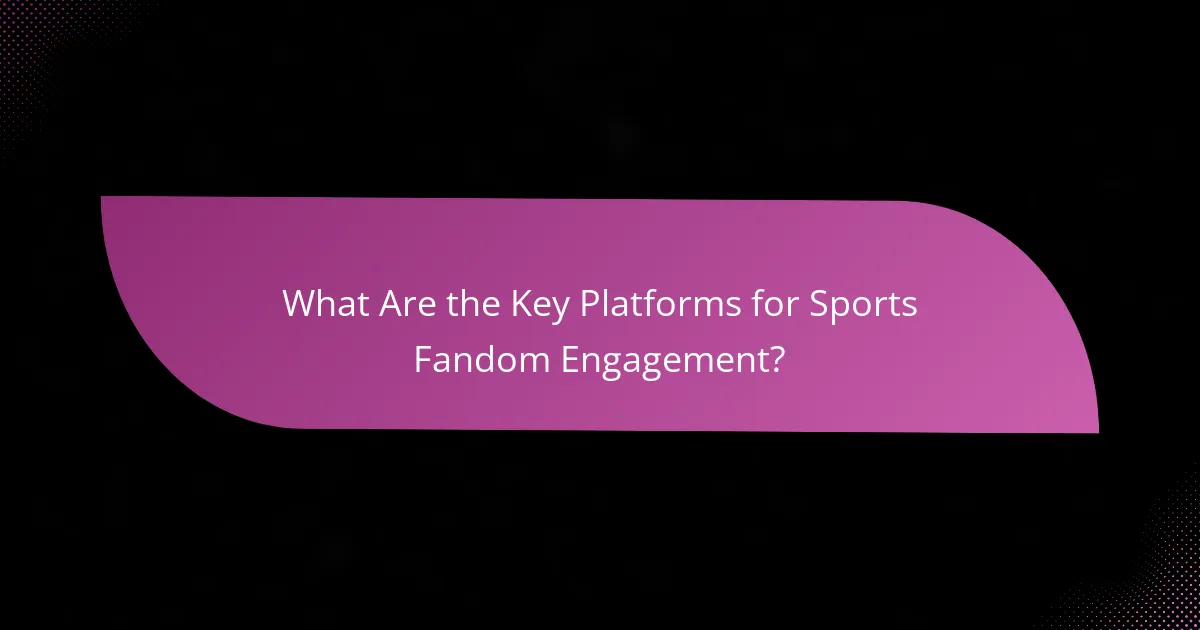Sports fandom communities are characterized by deep emotional connections between fans and their teams, fostering loyalty through shared experiences and exclusive benefits. Effective engagement strategies, such as social media interaction and gamification, enhance the fan experience and promote active participation. Additionally, cultural influences shape the identities and values of fans, creating a vibrant environment where commitment and community flourish.

How Do Sports Fandom Communities Foster Loyalty?
Sports fandom communities foster loyalty by creating deep emotional ties between fans and their teams, encouraging shared experiences, and providing exclusive benefits. These elements work together to build a strong sense of belonging and commitment among supporters.
Emotional connections to teams
Emotional connections to teams are fundamental in fostering loyalty within sports fandom communities. Fans often develop strong attachments based on personal experiences, family traditions, or regional pride. This emotional investment can lead to lifelong support, as fans celebrate victories and endure losses together.
For instance, a fan who grew up attending games with family may feel a profound sense of loyalty tied to those memories. This connection often transcends mere entertainment, becoming a vital part of their identity.
Shared experiences among fans
Shared experiences among fans strengthen community bonds and enhance loyalty. Attending games together, participating in watch parties, or engaging in discussions on social media creates a sense of camaraderie. These shared moments allow fans to connect over their passion for the team, reinforcing their loyalty.
For example, fans who travel to support their team during playoffs often form lasting friendships, which can further deepen their commitment to the team and its community.
Exclusive membership benefits
Exclusive membership benefits play a significant role in fostering loyalty within sports fandom communities. Many teams offer perks such as early ticket access, discounts on merchandise, or members-only events. These incentives not only reward loyal fans but also create a sense of belonging.
Fans who invest in season tickets or join official fan clubs often feel more connected to the team, as they receive unique opportunities to engage with players and other supporters.
Community events and gatherings
Community events and gatherings are essential for building loyalty among sports fans. These events, such as fan festivals, meet-and-greets, or charity functions, provide opportunities for fans to interact with each other and the team. Such interactions can deepen emotional ties and reinforce loyalty.
Participating in local events, like tailgating before games or attending team-sponsored activities, allows fans to celebrate their shared passion and strengthen their commitment to the community and the team.

What Engagement Strategies Are Effective in Sports Fandom?
Effective engagement strategies in sports fandom include leveraging social media, encouraging fan-driven content, facilitating live event participation, and incorporating gamification elements. These approaches foster loyalty and enhance the overall fan experience by creating a sense of community and active involvement.
Social media interaction
Social media platforms serve as vital tools for engaging sports fans by enabling real-time communication and interaction. Teams and organizations can share updates, behind-the-scenes content, and engage in conversations with fans, which helps build a loyal community. Regularly responding to fan comments and messages can significantly enhance this connection.
To maximize impact, teams should focus on creating shareable content, such as polls, quizzes, and live Q&A sessions. Utilizing popular platforms like Twitter, Instagram, and TikTok can help reach a broader audience and encourage fan participation.
Fan-driven content creation
Encouraging fans to create their own content can strengthen community ties and increase engagement. This can include fan art, blogs, videos, or social media posts that reflect their passion for the team. Highlighting this content on official channels not only validates fan efforts but also inspires others to contribute.
Teams can run contests or campaigns that incentivize fans to share their creations, such as giveaways or features on the team’s website. This approach not only boosts fan morale but also generates organic content that can attract new supporters.
Live event participation
Live events, whether games or fan festivals, provide opportunities for fans to engage directly with their teams and fellow supporters. These events create memorable experiences that deepen loyalty and foster a sense of belonging. Organizing meet-and-greets, fan zones, or interactive activities can enhance the live experience.
To encourage attendance, teams should offer exclusive merchandise, discounts, or special access to events for loyal fans. Engaging fans during the event through social media or live polls can also enhance their experience and encourage future participation.
Gamification of fan experiences
Gamification involves incorporating game-like elements into fan experiences to boost engagement and loyalty. This can include point systems, leaderboards, and rewards for participation in various activities, such as attending games or engaging on social media. By making the experience more interactive, fans are more likely to stay involved.
Teams can implement mobile apps that track fan engagement and offer rewards for reaching certain milestones. This not only incentivizes participation but also provides valuable data on fan preferences and behaviors, allowing for tailored engagement strategies.

How Does Culture Shape Sports Fandom Communities?
Culture significantly influences sports fandom communities by shaping the values, behaviors, and identities of fans. These cultural elements create a unique environment where loyalty and engagement thrive, fostering a sense of belonging among supporters.
Regional cultural influences
Regional culture plays a crucial role in defining sports fandom. For instance, in the United States, college football has a massive following in the South, where traditions and rivalries are deeply embedded in local culture. In contrast, European football (soccer) clubs often reflect the historical and social fabric of their cities, with fans identifying strongly with their local teams.
Fans often express their cultural identity through their support for teams, which can include wearing team colors, participating in local events, and engaging in community outreach. This connection to regional culture enhances the emotional investment fans have in their teams.
Historical significance of teams
The historical context of a sports team can greatly influence its fandom. Teams with rich histories, such as the Boston Red Sox or FC Barcelona, often cultivate passionate followings due to their storied pasts and significant achievements. Fans are drawn to the legacy and the narratives that these teams represent.
Moreover, the historical significance can also encompass social movements or changes within a community. For example, teams that emerged during pivotal moments in history often become symbols of resilience and pride, further solidifying their fan base.
Rituals and traditions
Rituals and traditions are fundamental to sports fandom, providing fans with a sense of continuity and community. Common practices include tailgating before games, singing team anthems, and celebrating victories with specific rituals. These activities enhance the overall experience of being a fan.
Additionally, traditions can vary widely between regions and sports. For example, in American football, the Super Bowl has become a cultural event with its own set of rituals, while in cricket, the tradition of tea breaks is an integral part of the match experience. Understanding these rituals helps fans connect more deeply with their teams and fellow supporters.

What Are the Key Platforms for Sports Fandom Engagement?
Key platforms for sports fandom engagement include social media networks and community forums where fans can connect, share, and discuss their favorite teams and players. These platforms foster loyalty and create a vibrant culture around sports, allowing fans to interact in real-time and build lasting relationships.
Facebook groups
Facebook groups serve as dedicated spaces for fans to gather and discuss their interests. These groups often focus on specific teams, leagues, or sports, providing a platform for sharing news, game highlights, and personal opinions.
Engagement in Facebook groups can be enhanced by regular posts, polls, and live discussions during games. However, it’s essential to moderate content to maintain a positive atmosphere and prevent conflicts among members.
Reddit communities
Reddit hosts numerous sports-related subreddits where fans can participate in discussions, share memes, and post game analyses. Each subreddit typically has its own rules and culture, which can vary significantly between different sports or teams.
Active participation in Reddit communities often includes commenting on game threads and contributing to AMAs (Ask Me Anything) with players or sports analysts. Users should be mindful of subreddit guidelines to ensure their contributions are well-received.
Discord servers
Discord servers provide real-time communication for sports fans through text and voice channels. These servers can be dedicated to specific teams or broader sports discussions, allowing fans to engage in lively conversations during games.
To maximize engagement on Discord, consider hosting watch parties or trivia nights. It’s crucial to establish clear rules for behavior to create a welcoming environment for all fans, regardless of their level of knowledge or enthusiasm.

How Do Demographics Influence Sports Fandom?
Demographics play a crucial role in shaping sports fandom, affecting how individuals engage with teams and sports culture. Factors such as age, gender, and socioeconomic status can significantly influence preferences, participation levels, and community involvement.
Age group preferences
Different age groups exhibit distinct preferences in sports fandom, often influenced by cultural trends and media consumption. Younger fans may gravitate towards sports that are heavily marketed on social media platforms, while older generations might prefer traditional sports with a long-standing history.
For example, millennials and Gen Z fans often engage more with esports and fast-paced sports like basketball, while baby boomers may favor football and baseball. Understanding these preferences can help teams tailor their marketing strategies effectively.
Gender representation
Gender representation in sports fandom has evolved, with increasing participation from women in various sports. Historically male-dominated sports are seeing a rise in female fans, driven by greater visibility and support for women’s leagues.
Teams and organizations that actively promote inclusivity and female representation can tap into this growing demographic. For instance, marketing campaigns featuring female athletes can resonate well with female fans, enhancing engagement and loyalty.
Socioeconomic factors
Socioeconomic status significantly impacts sports fandom, influencing access to games, merchandise, and overall engagement. Fans from higher socioeconomic backgrounds may have more opportunities to attend live events and purchase team-related products.
Conversely, fans from lower socioeconomic backgrounds might rely on digital platforms for engagement, such as streaming games online or participating in fantasy leagues. Teams that recognize these differences can create targeted outreach programs to foster community support and engagement.
